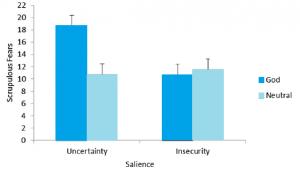An exhibition at Gallery of Modern Art in Glasgow is proving to be just a bit more controversial than the organizers had hoped for. One of the exhibits featured a bible, and a pen, and an encouragement homosexuals to write uplifting messages in the margins. Tragically, it seems that some homosexuals don’t feel too warmly to the Bible and some of the comments were unkind, even going so far as to call the book “the biggest lie in human history”.
All this has upset the Pope, according to the Telegraph:
The adviser to the head of the Catholic Church said the project was “disgusting and offensive”.
It’s an interesting choice of words, that. Offensive I can understand, but disgusting?
As luck would have it I’ve just been reading a new study on ‘disgust’. The authors tackled a long standing problem on how to classify different types of disgust. The classical model, based on a study done by Jon Haidt, breaks disgust into three domains – core disgust, animal reminder disgust, and interpersonal disgust.
The problem with this is that it’s hard to figure out what the functional value of these three domains is. What’s the survival value – why would they evolve?
So the new paper proposes a revised model, based around three domains that are linked directly to evolutionary benefit. Now, the interesting bit is how they developed the model.
Basically what they did was to a group of 14 people to write down 15 different things that some people might think were disgusting. They whittled this down to 58 unique items, and asked a larger group of undergrads to rate them on how disgusting each was. Then they used a statistical technique (factor analysis) to see how the groups bunched up.
As they expected, they found that there are basically three types of disgust:
- Pathogen disgust (things like “Standing next to someone who has strong body odour”), which helps to keep you free of infection.
- Sexual disgust (e.g. “Having sex with a much older person”), which safeguards against bad reproductive decisions, and is much more powerful for women than for men.
- Moral disgust (e.g. “Forging a signature”), which helps to stop you doing antisocial things, which could lead to you becoming ostracised.
So where does the Pope’s disgust for the Glasgow exhibition fit into this list? You might think that it fits under ‘moral disgust’, but in fact all the examples in that category are about social interactions – lying, cheating, and stealing. They don’t seem really to cover it.
Perhaps it’s sexual disgust. The offending people were homosexuals, after all, and a lot of the scribblings that caused the ruction were sexual (“I am Bi, Female & Proud. I want no god who is disappointed in this”). What’s more, another of the exhibits featured video of a woman tearing out pages of the bible and stuffing them into her underwear!
But my gut feeling says something different. I think that a lot of religious people experience ‘sacred disgust’. They feel that certain objects and places have special, magical properties, and they react with disgust when these objects are violated in much the same way as they would when a person is violated.
If that’s true, then the Pope’s disgust is a form of moral disgust, but it’s moral disgust transferred to objects, rather than people.
The problem with this idea is that the three domains of disgust (pathogen, sexual, moral) are supposed to have evolved because they provide a clear survival benefit. But what would be the survival benefit of moral disgust linked to objects?
_______________________________________________________________________________________![]()
Tybur, J., Lieberman, D., & Griskevicius, V. (2009). Microbes, mating, and morality: Individual differences in three functional domains of disgust. Journal of Personality and Social Psychology, 97 (1), 103-122 DOI: 10.1037/a0015474
 This work by Tom Rees is licensed under a Creative Commons Attribution-Share Alike 2.0 UK: England & Wales License.
This work by Tom Rees is licensed under a Creative Commons Attribution-Share Alike 2.0 UK: England & Wales License.













